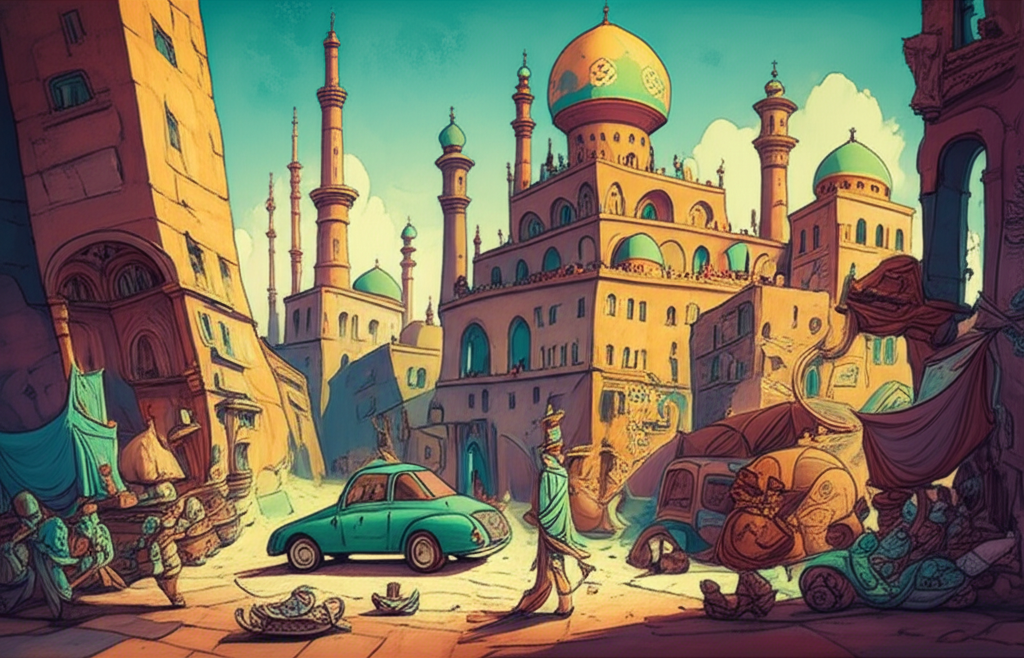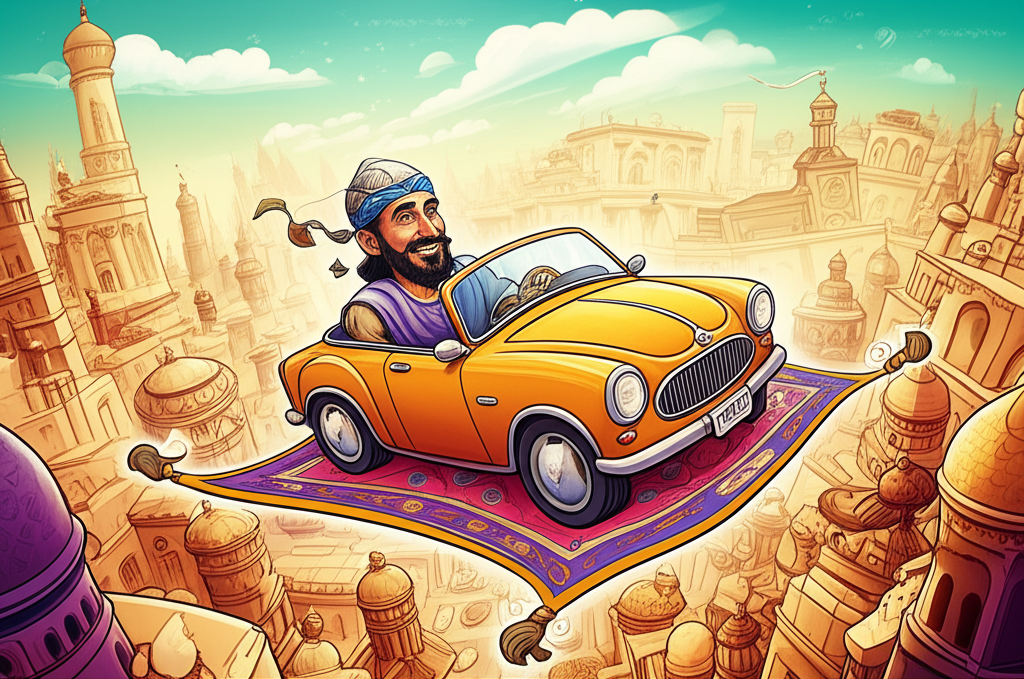
Introduction
Among the myriad tales that have captivated audiences for centuries, none quite evoke the blend of wonder, mystery, and cautionary wisdom as "The City of Brass." This enthralling narrative originates from the rich tapestry of Middle Eastern folklore, specifically finding its prominent place within One Thousand and One Nights, also known as The Arabian Nights. It is crucial to understand from the outset that this is a traditional story, a product of ancient peoples’ vivid imaginations and cultural expressions, not a historical account or a belief system to be adopted. It stands as a testament to the power of storytelling to convey profound ideas about life, mortality, and the human condition.
Origins and Cultural Background
The cultural era in which tales like "The City of Brass" flourished was largely that of the Abbasid Caliphate, a period often referred to as the Golden Age of Islam (roughly 8th to 13th centuries CE). This was an epoch of unparalleled intellectual, scientific, and artistic achievement, centered in bustling metropolises like Baghdad, Cairo, and Damascus. The environment was one of vibrant trade routes connecting East and West, fostering a melting pot of diverse cultures – Persian, Indian, Greek, and Arab traditions intertwining to create a unique synthesis of knowledge and imagination.
People of this time viewed the world as a place imbued with both the tangible and the unseen. While deeply rooted in faith and the recognition of Allah as the singular Creator and Sustainer, their worldview also embraced the existence of jinns (genies), powerful magical artifacts, and hidden wonders waiting to be discovered beyond the known horizons. Exploration, both geographical and intellectual, was highly valued. Scholars meticulously translated ancient texts, astronomers mapped the stars, and adventurers charted new territories. It was a society that celebrated human curiosity and ingenuity, yet simultaneously acknowledged the ephemeral nature of worldly power and the ultimate sovereignty of the Divine. Myths and legends served not just as entertainment, but as vehicles for moral instruction, historical memory, and a means to grapple with the grand mysteries of existence.
Character / Creature Description
In "The City of Brass," the primary "character" is not a living being but the eponymous city itself: a legendary, abandoned metropolis. It is envisioned as an architectural marvel, its towering walls and majestic structures forged entirely from gleaming, resonant brass, reflecting the sun with an unnatural brilliance. This extraordinary material imbues the city with an aura of invulnerability and timelessness. Its defenses are often described as automatic and intricate, hinting at an advanced, almost magical, engineering lost to time.
Symbolically, the City of Brass represents the zenith of human achievement and hubris. It is a testament to a civilization that reached unimaginable heights of power and wealth, yet ultimately succumbed to a mysterious fate. The city’s true inhabitants, when eventually discovered, are not living, but perfectly preserved – either mummified, petrified, or held in a state of suspended animation, frozen in their daily routines. They are symbols of the transience of all worldly glory, a silent, chilling tableau of a once-thriving populace brought to an abrupt halt. The very brass of the city, while signifying strength and resilience, also hints at an unyielding, cold, and ultimately lifeless existence once its vibrant spirit departed. It is a monument to the impermanence of mortal endeavors and a stark reminder that even the most magnificent creations can be reduced to dust and silence.
Main Story / Narrative Retelling
The tale of the City of Brass begins in Damascus, where a powerful Caliph, hearing whispers of a legendary city of immense wealth and Solomon’s fabled brass bottles containing imprisoned jinns, dispatches a seasoned expedition. Led by a valiant emir, often named Musa ibn Nusayr in various retellings, the company sets forth across vast, unforgiving deserts and perilous mountain passes. Their journey is long and arduous, fraught with encounters with strange beasts, mirages, and the ever-present threat of the elements. Yet, driven by the Caliph’s command and the allure of untold riches and ancient wisdom, they press on.
After weeks of relentless travel, a shimmering anomaly appears on the horizon – a colossal city, its walls catching the sun’s rays with an unnatural, golden-bronze glow. As they draw closer, the scale of the City of Brass becomes breathtakingly apparent. Its towering ramparts, built of polished brass, rise majestically from the desert floor, seemingly impregnable. Automated brass figures, some shaped like fearsome warriors, others like mythical beasts, stand sentinel upon the battlements, their mechanisms long since stilled, yet still radiating an aura of vigilance. The massive gates, too, are of brass, intricately carved and sealed.
With ingenuity and perseverance, the expedition finally breaches the city’s defenses. What awaits them inside is both magnificent and profoundly unsettling. The streets are pristine, devoid of dust or debris, yet utterly silent. Palaces of breathtaking grandeur stand untouched, their doors ajar. Markets are filled with stalls laden with goods, jewels sparkle in forgotten treasuries, and libraries house scrolls of ancient knowledge – all perfectly preserved, as if time itself had ceased the moment its inhabitants vanished. There is no sign of struggle, no mark of destruction, only an eerie, profound stillness.
As they delve deeper, the full, chilling "aftermath" reveals itself. In the royal palace, a king sits enthroned, his robes still vibrant, his crown upon his head, yet his eyes are vacant, his skin like hardened parchment. In the kitchens, a baker stands poised before his oven, a loaf of bread still in his hands. Children are frozen in mid-play in courtyards, their toys scattered around them. Everywhere, the inhabitants of the City of Brass are found, perfectly preserved in their daily routines, silent witnesses to their own inexplicable demise. They are mummified, not by human hand, but by an unknown force, their lives captured in a tableau of eternal stasis.
Within the city, the expedition discovers ancient inscriptions etched into tablets of gold and stone. These inscriptions recount the history of the City of Brass: a mighty civilization, blessed with immense wealth and power, whose king grew arrogant and defied the divine. They worshipped idols, indulged in excess, and forgot their Creator. As a consequence of their hubris and transgression, a divine decree (or, in some versions, a powerful jinn) swept through the city, extinguishing every living soul in a single, silent moment, preserving them as a permanent warning. One inscription famously declares: "O you who come after us, learn from our fate! This is the end of all worldly glory and might. We lived and sinned, and thus we perished." The expedition returns to Damascus, not laden with the brass bottles of Solomon, but with a far more potent treasure: the harrowing tale of the City of Brass and its profound lesson about the fleeting nature of worldly power and the ultimate judgment of the Divine.
Symbolism and Meaning
To the ancient peoples who shared this myth, "The City of Brass" represented a multitude of profound ideas. Foremost, it served as a powerful cautionary tale about the transience of worldly power and wealth. No matter how grand or enduring human creations may seem, they are ultimately ephemeral in the face of divine will. The city’s untouched splendor, juxtaposed with its utterly lifeless inhabitants, underscored the vanity of human ambition when divorced from spiritual humility.
It also symbolized divine judgment and the consequences of hubris. The city’s fall was attributed to its inhabitants’ arrogance and their turning away from the Creator, serving as a stark reminder that even the most powerful civilizations are accountable for their actions. Furthermore, the story speaks to human curiosity and the pursuit of knowledge or wealth. The expedition itself embodies humanity’s relentless drive to explore the unknown, to uncover hidden wonders, and to seek out ancient wisdom, even if the discoveries are unsettling. Finally, the City of Brass, with its silent, preserved denizens, evoked the allure of lost civilizations and the profound mystery of what lies beyond the veil of known history, prompting reflection on mortality and the cycles of rise and fall that govern all earthly existence.
Modern Perspective
In contemporary times, "The City of Brass" continues to resonate, albeit in new forms and interpretations. It has become a wellspring of inspiration for modern literature, movies, and games, contributing significantly to the genre of fantasy and speculative fiction. The concept of a lost, technologically advanced, or magically preserved city of immense wealth and chilling secrets is a recurring motif, directly influenced by this ancient tale. For instance, elements of the City of Brass can be seen in the elaborate, lost cities of fantasy novels, the mysterious ruins explored in video games (like the "City of Brass" as a plane in Dungeons & Dragons), and even the grand, often ominous, settings of cinematic adventures.
Modern cultural studies often interpret the myth not as a literal historical account, but as a rich source for understanding medieval Islamic views on morality, exploration, and the relationship between humanity and the divine. It is analyzed for its literary structure, its narrative power, and its psychological depth, reflecting timeless human concerns. Today, it stands as a testament to the enduring power of imagination and the universal appeal of stories that explore grand themes of ambition, downfall, and the search for meaning.
Conclusion
"The City of Brass" is, in essence, a magnificent piece of cultural heritage, a testament to the boundless imagination and storytelling tradition of ancient peoples. It is a legend, a myth, and a narrative crafted to entertain, educate, and provoke thought, not a belief system to be adopted or a historical event to be taken literally. As Muslims, we recognize that Allah alone is the true Creator and Sustainer of the universe, and that His power and majesty far transcend any human-conceived narrative or mythological construct. This story, like many others from The Arabian Nights, enriches our understanding of the diverse ways in which humanity has sought to comprehend the world, to grapple with moral dilemmas, and to express the wonders and perils of existence through the compelling art of storytelling. It reminds us of the enduring legacy of human creativity and the timeless value of narratives that continue to inspire and reflect upon the human journey across generations.





